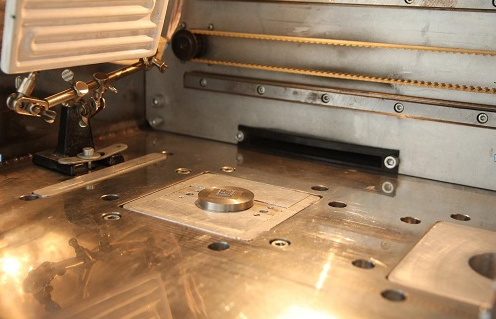
Additive Manufacturing of Titanium Aircraft Parts
source:Photonics
release:Nick
keywords: Additive Manufacturing; 3D laser printing
Time:2017-11-06
TOMSK, Russia, Nov. 3, 2017 — An additive manufacturing technology that uses direct metal laser sintering enables the printing of titanium aircraft parts with a modified surface layer.
Physicists from Tomsk Polytechnic University (TPU) are currently working to create hydrogen-resistant products out of titanium alloys. The production of metal products via additive manufacturing ensures less material consumption as well as possibilities to develop complex geometric products. The Russian Science Foundation has given TPU a three-year grant for the creation of hydrogen-resistant products from titanium alloys Ti-6Al-4V, Ti-6.5Al-3.5Mo-1.5Zr-0.3Si.

 A 3D-printed titanium sample. Courtesy of Tomsk Polytechnic University.
A 3D-printed titanium sample. Courtesy of Tomsk Polytechnic University.
Titanium products are widely used in aircraft construction due to their strength, and account for 15 to 20 percent of a modern civil aircraft. Today, these parts are produced with traditional foundry though.
"In Russia it is a fairly new technology. To introduce it, special 3D-printing equipment and powder production installation should be developed. Thus, there is a great scope for research,” said Natalia Pushilina, associate professor at TPU’s Department of General Physics. “This equipment is increasingly in high demand as evidenced by the great number of scientific publications devoted to additive manufacturing technology in the field of metal processing. Over the past few years, their number has significantly increased in leading scientific publication databases, which signifies a great interest in the international community.'
Pushilina and her team plan to print aircraft parts out of BT6 and BT9 titanium alloys. BT6 is a widespread material being produced in Russia, while BT9 will be obtained by TPU out of crystalline titanium.
“For the research, we chose these two materials, as they have been applied in aircraft construction due to their properties,” said Pushilina. “BT6 is used to manufacture turbine parts subject to high temperatures, corrosive media and saturation with atmospheric hydrogen during operation.”
According to the researchers, 3D-printing with titanium alloys differs from traditional processes in that it relies on laser-based additive manufacturing technology that makes it possible to make parts of any configuration. It also uses much less materials.
“With 3D technology you can print any part. This goes beyond mass production supported by plants that daily cast a great deal of products,” said engineer Viktor Kudiyarov. “Our goal is to develop a technology for printing individual complex parts out of titanium.”
TPU scientists are determined to reveal patterns between various print parameters and characteristics of manufactured items. So far, they have identified over 10 parameters. By varying them, it is possible to create products with different specified properties and products with gradient surface layers.
Currently, such modification of products requires an additional production process. First, a homogeneous part is made, then an additional coating is applied. The technology developed by TPU scientists combines the two processes. Products are printed immediately with a modified layer.
TPU physicists are committed to showing the advantages of titanium parts produced by using advanced additive technology.
- RoboSense is to Produce the First Chinese Multi-beam LiDAR
- China is to Accelerate the Development of Laser Hardening Application
- Han’s Laser Buys Canadian Fiber Specialist CorActive
- SPI Lasers continues it expansion in China, appointing a dedicated Sales Director
- Laser Coating Removal Robot for Aircraft
 FISBA exhibits Customized Solutions for Minimally Invasive Medical Endoscopic Devices at COMPAMED in
FISBA exhibits Customized Solutions for Minimally Invasive Medical Endoscopic Devices at COMPAMED in New Active Alignment System for the Coupling of Photonic Structures to Fiber Arrays
New Active Alignment System for the Coupling of Photonic Structures to Fiber Arrays A new industrial compression module by Amplitude
A new industrial compression module by Amplitude Menhir Photonics Introduces the MENHIR-1550 The Industry's First Turnkey Femtosecond Laser of
Menhir Photonics Introduces the MENHIR-1550 The Industry's First Turnkey Femtosecond Laser of Shenzhen DNE Laser introduced new generation D-FAST cutting machine (12000 W)
more>>
Shenzhen DNE Laser introduced new generation D-FAST cutting machine (12000 W)
more>>
